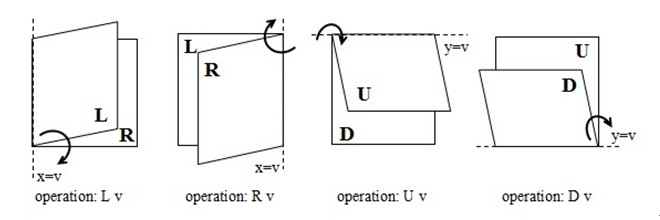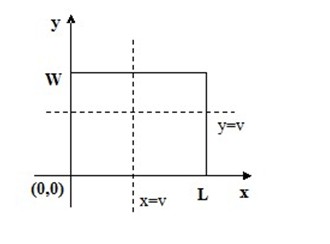
| Online Judge | Online Exercise | Online Teaching | Online Contests | Exercise Author |
|
F.A.Q Hand In Hand Online Acmers |
Best Coder beta VIP | STD Contests DIY | Web-DIY beta |
Chinese Paper Folding
Time Limit: 10000/5000 MS (Java/Others) Memory Limit: 65536/32768 K (Java/Others)Total Submission(s): 250 Accepted Submission(s): 61
Problem Description
Chinese Paper Folding, or Zhezhi, is the art of folding paper that originated in China. It is the predecessor of origami.
Here we only consider a simplified problem. You are given a paper L cm by W cm in size and a list of operations to fold it.
Four types of operation are listed below:
1. L v , fold the left part of paper along the straight line x = v.
2. R v , fold the right part of paper along the straight line x = v.
3. U v , fold the upper part of paper along the straight line y = v.
4. D v , fold the lower part of paper along the straight line y = v.
Note that v is always an integer.

We define the left-lower corner of current paper as (0, 0) at every step (refer to the picture below). It is guaranteed that each operation is legal, that is, each operation is asked to fold paper of a positive area.

It is obvious that folding will make the straight lines into creases. We wonder the total length of all creases when paper is completely unfolded.
Here we only consider a simplified problem. You are given a paper L cm by W cm in size and a list of operations to fold it.
Four types of operation are listed below:
1. L v , fold the left part of paper along the straight line x = v.
2. R v , fold the right part of paper along the straight line x = v.
3. U v , fold the upper part of paper along the straight line y = v.
4. D v , fold the lower part of paper along the straight line y = v.
Note that v is always an integer.

We define the left-lower corner of current paper as (0, 0) at every step (refer to the picture below). It is guaranteed that each operation is legal, that is, each operation is asked to fold paper of a positive area.

It is obvious that folding will make the straight lines into creases. We wonder the total length of all creases when paper is completely unfolded.
Input
In the first line there is an integer T, indicates the number of test cases. (T <= 50)
For each case, the first line is a pair of integers L and W (1 <= L, W <= 1,000,000), which stands for the length and width of the paper. In the second line, an integer K stands for the number of operations. (K <= 100000) Then K lines follow, each stands for an operation described above.
For each case, the first line is a pair of integers L and W (1 <= L, W <= 1,000,000), which stands for the length and width of the paper. In the second line, an integer K stands for the number of operations. (K <= 100000) Then K lines follow, each stands for an operation described above.
Output
For each case, output “Case x: R" on a single line, in which x is the case number counted from one, R is the total length of all creases.
Sample Input
2 50 50 4 L 30 D 5 R 3 U 5 65536 1 16 L 32768 L 16384 R 8192 R 4096 L 2048 R 1024 L 512 R 256 R 128 L 64 R 32 R 16 L 8 R 4 L 2 R 1
Sample Output
Case 1: 250 Case 2: 65535
Author
love8909
Source
| Home | Top |
Hangzhou Dianzi University Online Judge 3.0 Copyright © 2005-2025 HDU ACM Team. All Rights Reserved. Designer & Developer : Wang Rongtao LinLe GaoJie GanLu Total 0.001000(s) query 1, Server time : 2025-04-09 07:00:13, Gzip enabled |
Administration |